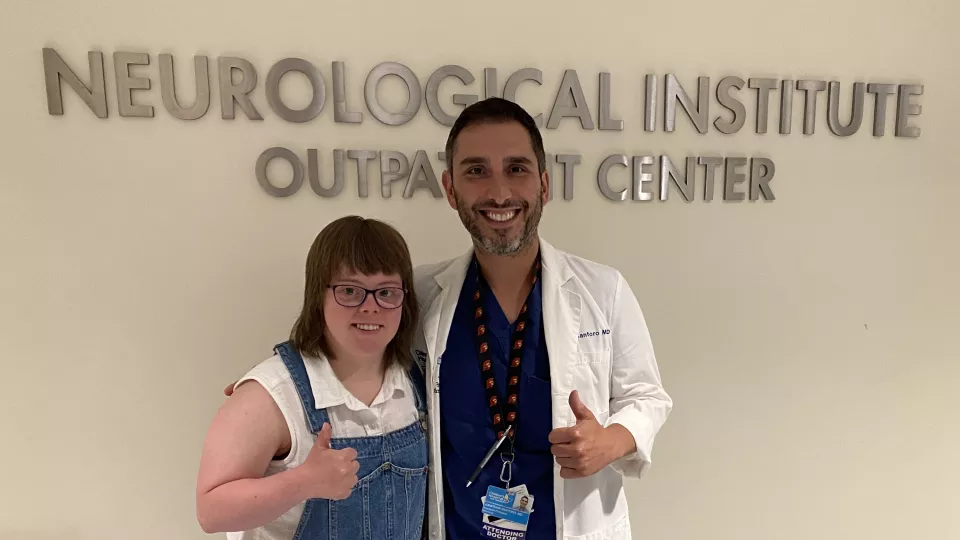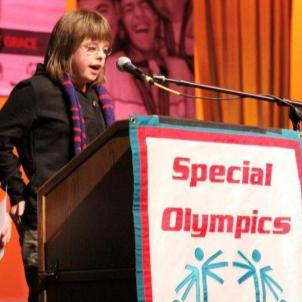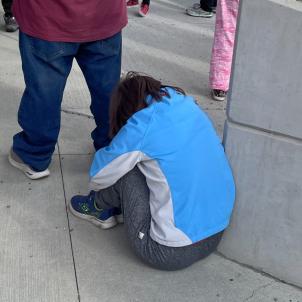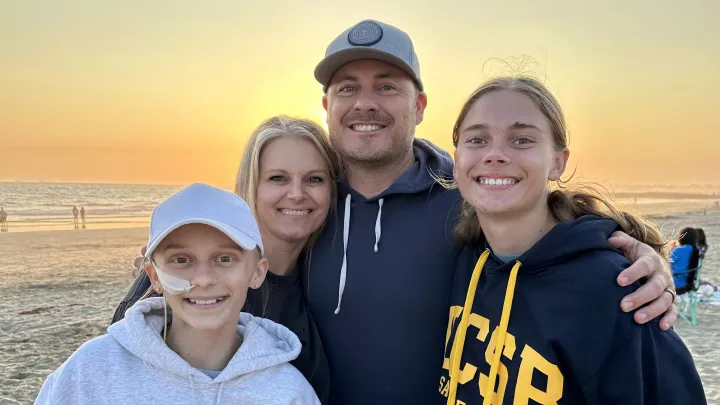
Darci and Dr. Santoro in CHLA’s Neurological Institute Outpatient Center during one of Darci's appointments while receiving treatment for DSRD (June 2024)
New Treatment for Down Syndrome Regression Disorder Helps Bring Darci Back to Herself
Track and field star, bowler, floor hockey player, health coach, cooking show host, public speaker—all these words describe Darci.
Growing up with Down syndrome, a genetic condition that results in intellectual disabilities and developmental delays, never kept Darci from staying busy. She excelled in leadership roles and in team settings in her home state of Alaska and participated in mainstream school life.
“In high school, she was in the marching band,” Dana says. “She was varsity high school basketball manager, and she traveled with the team independently, without me. She went to an after-school program where they learn job skills up until she was 21. After that, she got a job with Special Olympics.”
Working for the largest sports organization in the world for individuals with intellectual disabilities, Darci filled an important role.
“Initiatives Assistant,” Darci says proudly. This position involved assisting with clubs at Special Olympics Unified Schools. Beyond her job, Darci was deeply involved with the organization as an athlete, playing multiple sports, and as a public speaker at Special Olympics games and PR events. As Dana says, “You gave this girl a microphone and she could light up a crowd.”

Darci was also the first Special Olympics athlete to become a certified health coach for the organization in Alaska, teaching other athletes how to maintain a healthy lifestyle and hosting a YouTube cooking show. She would even travel with the Seattle Seahawks when the football team would visit Alaska.
Then, in early 2022, things started to change. First, Darci began to mysteriously lose weight. Next came confusion. “Darci would unload the dishwasher and take a spatula and try to put it in the fridge,” Dana says. “She would stand there and she was able to verbalize, ‘I’m confused.’” It quickly got worse.
A search for answers
“The week of April 11 is when it hit with a vengeance,” Dana explains. Darci stopped eating and began hallucinating. “There was one time it was so bad that I had to stop the car on the highway because I thought she was going to jump out.”
The weight loss ramped up. Darci lost 30% of her body weight and was down to 89 pounds. She lost her ability to bathe or dress herself. An accomplished 28-year-old, Darci was estimated to be functioning at an 18-month-old level. “It was getting pretty scary,” says Dana.
She brought Darci to various medical providers in Alaska, but they could not diagnose her. “I had always heard that this population [those with Down syndrome] was underserved medically, and I had never experienced that personally,” Dana says. She has worked in health care for 31 years and is Manager of Therapy Services at Alaska Regional Hospital. But she was shocked at how difficult it was to get a straight answer from the providers she and Darci were seeing.
One gastrointestinal specialist told Dana that he couldn’t help Darci if she chose not to eat, and Dana had to reiterate that Darci wasn’t choosing not to eat. When they saw a neurologist, Dana was told almost immediately that Darci must have schizophrenia.
“I was like, ‘Based on what diagnosis are you saying that?’” Dana recalls. “This doctor said that her speech was fluent. Darci was mute at that point."

Dana was able to bring Darci to a psychiatrist who prescribed an antipsychotic medication, which eliminated Darci’s hallucinations. But her other symptoms continued as Dana persisted in her search for answers.
“We did have one primary care provider [PCP] who had known Darci since we transitioned from pediatric care at 18,” she explains. The doctor was also having trouble diagnosing Darci, but Dana says she offered something the other providers didn’t: hope. “She was the one person who was like, ‘I don’t know what it is, but we’re going to find it.’”
And eventually, they did. Dana researched Darci’s symptoms on her own. “I was just plugging in anything that I could find that would match Darci’s symptoms. What kept popping up were Dr. Santoro’s articles. I was like, ‘Oh my gosh, this is what Darci has. I’ve got to pursue this path.’”
The path to CHLA
The articles Dana had discovered were the work of Jonathan D. Santoro, MD, Director of the Neuroimmunology Program at Children’s Hospital Los Angeles. Since 2019, Dr. Santoro had been working to develop a novel treatment protocol for DSRD. He recognized that DSRD was often misdiagnosed as schizophrenia, early-onset Alzheimer’s disease or late-onset autism. He saw that physicians tended to be so focused on a patient’s Down syndrome that they wouldn't fully investigate their individual symptoms.
“I just kept asking the question: Why are we treating these patients differently?” Dr. Santoro says. He became determined to better understand DSRD and identify new ways to treat it.
He tested patients with DSRD for conditions that could be affecting the brain and found inflammatory markers in the patients’ cerebrospinal fluid. Evidence began to grow that DSRD could be treated as an inflammatory condition.
This data led Dr. Santoro and CHLA to launch the first clinical trial for DSRD. A National Institutes of Health-funded collaboration with the University of Colorado and Children’s Hospital Colorado, the trial is investigating the safety and effectiveness of three potential treatments: lorazepam, a medicine that treats catatonia; an immune therapy called intravenous immunoglobin (IVIg); and Tofacitinib, a drug that suppresses an individual's immune system.
By the time Dana reached out to Dr. Santoro, he was deeply familiar with DSRD. “He and our PCP connected and he gave her the diagnostics that we needed to run,” Dana says. Dana and Darci finally received a DSRD diagnosis seven months after the onset of Darci’s symptoms. “Then we went straight to Dr. Santoro in California to initiate our treatments.”
A simple task, but a huge step forward
Dr. Santoro recalls meeting Dana and Darci in person for the first time at CHLA. “The thing that I was most struck by was what Darci used to do,” he says. “I mean, she’s not just a typical young woman—she's leading Special Olympics, she’s the upstanding citizen in her community, she just does so much. So to meet her and see this shell of a person—it was a very emotional visit between Dana and Darci and myself.”
Dr. Santoro initially prescribed lorazepam to address Darci’s catatonia. The first signs of improvement emerged during the pandemic. “We were still using masks,” Dana recalls, tearing up. “The first thing Darci did independently was she went and put all the masks by the door in a basket. That seems like a silly task—putting masks in a basket. But when you’ve gone seven months with just nothing—sitting on the couch and just being catatonic and not able to do anything—that simple task was just huge.”
The progress continued. Darci regained the ability to dress herself and eat on her own. Then, after Dana worked hard to obtain coverage from her insurance provider, Darci began IVIg infusions. “She’s been on that for about 16 months,” Dana says. “And we continue to see improvements.” The changes aren’t as drastic as they were when Darci started treatment, but every step forward is major.
Dr. Santoro also emphasizes that Darci’s providers in Alaska were open to discussing Darci’s progress, as well as his research. This helped immensely in monitoring Darci’s treatment between her visits to CHLA.
“We shared the literature and we talked about what to monitor for, and the doctors over there were really fantastic,” he says.
Gratitude and goal setting
Through this experience, Darci has been attending a Family Outreach Center for Understanding Special Needs (FOCUS) in Alaska to re-engage in activities like community service. She has been involved with FOCUS since childhood, and they have played an important role in her DSRD journey. The FOCUS team brought Darci back to the space where she used to host her cooking show, and she has started to cook again.

Dana happily describes Darci’s present state. “Treatment’s going great,” she says. “Of all of the symptom clusters that are DSRD, most of them are gone.” The areas that they are still working on with Dr. Santoro are Darci’s speech and her internal motivation to independently perform tasks.
Dr. Santoro understands that while Darci is on a positive path, many others with DSRD need help.
“We get hundreds of emails a month from people all over the world,” he says. To support these individuals, Dr. Santoro remains committed to translating his research into new treatments as quickly as possible. “Being fast has really allowed us to totally change the landscape, and I think that will continue in the next couple of years as we get more and more data.”
As Dana and Darci look ahead, Special Olympics has assured them that there will be a position for Darci when she is ready to return. At the mention of this, Darci smiles wide and gives a thumbs up. Dana looks forward to Darci being able to organize the FOCUS Halloween party and to dance at Special Olympics dances again.
Dana also recognizes how much she and Darci have had to grow through this experience. “I think it has brought out a spirit of advocacy,” she explains. “I’m advocating for lifesaving care for her—and I’m telling this story so that any other physician, health care provider or parent can just know what this is so they don’t have to search for answers like so many of us have.”
Meanwhile, Darci is steadily resuming the activities she used to enjoy. She cooks again—making breakfast with her mom and preparing some favorite dishes (like runny eggs and hash browns, she says). She asks to listen to songs that she hasn’t heard in a long time.
“She recognizes that she’s not doing something, and she says, ‘I want to do it,’” Dana explains. “That’s Darci’s goal.”


